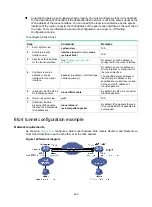
309
{
Configure a static route, and specify the local tunnel interface as the egress interface or
specify the IPv6 address of the peer tunnel interface as the next hop.
{
Enable a dynamic routing protocol on both tunnel interfaces to achieve the same purpose.
For more information about route configuration, see
Layer 3—IP Routing Configuration Guide
.
To configure an IPv4 over IPv6 manual tunnel:
Step Command
Remarks
1.
Enter system view.
system-view
N/A
2.
Enter IPv6 tunnel
interface view.
interface tunnel
number
[
mode
ipv6
]
N/A
3.
Configure an IPv4
address for the tunnel
interface.
ip
address
ip-address
{
mask
|
mask-length
}
[
sub
]
By default, no IPv4 address is configured
for the tunnel interface.
4.
Configure the source
address or interface for
the tunnel interface.
source
{
ipv6-address
|
interface-type
interface-number
}
By default, no source address or interface
is configured for the tunnel.
The specified source address or the
primary IPv6 address of the specified
source interface is used as the source IPv6
address of tunneled packets.
5.
Configure the destination
address for the tunnel
interface.
destination
ipv6-address
By default, no destination address is
configured for the tunnel.
The tunnel destination address must be the
IPv6 address of the receiving interface on
the tunnel peer. It is used as the destination
IPv6 address of tunneled packets.
Configuration example
Network requirements
As shown in
, configure an IPv4 over IPv6 manual tunnel between Router A and Router B
so the two IPv4 networks can reach each other over the IPv6 network.
Figure 128 Network diagram
Configuration procedure
Make sure Router A and Router B can reach each other through IPv6.
•
Configure Router A:
# Specify an IPv4 address for GigabitEthernet 2/0/1.
<RouterA> system-view
[RouterA] interface gigabitethernet 2/0/1
[RouterA-GigabitEthernet2/0/1] ip address 30.1.1.1 255.255.255.0
















































